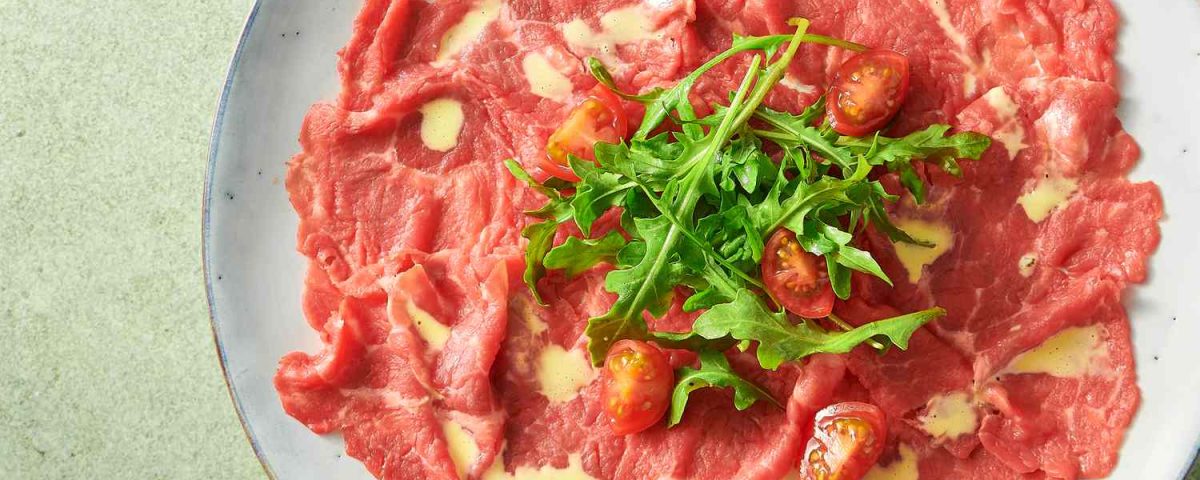
Cacciucco: A Flavorful Tuscan Seafood Stew

Chicken Parmesan: A Classic Italian-American Comfort Food
Carpaccio: A Delicate Italian Culinary Masterpiece
Introduction
Carpaccio, a stunningly presented and flavorful dish, is a true icon of Italian cuisine. Named after the Venetian painter Vittore Carpaccio, this culinary masterpiece features thinly sliced raw beef, typically accompanied by a drizzle of extra-virgin olive oil, a squeeze of lemon, and a sprinkling of Parmesan cheese. While the traditional version showcases beef, modern interpretations have expanded to include other types of meat, fish, and vegetables. In this comprehensive guide, we will explore the history, techniques, and variations of this elegant dish.

A Brief History of Carpaccio
The creation of carpaccio is often attributed to Giuseppe Cipriani, the owner of Harry’s Bar in Venice. In the 1950s, a young countess with anemia visited the restaurant and was unable to consume cooked meat. To accommodate her dietary restrictions, Cipriani created a dish using thinly sliced raw beef, inspired by the vibrant colors of Vittore Carpaccio’s paintings. The dish quickly gained popularity and became a signature item on the restaurant’s menu.
Essential Ingredients
- Beef: Traditionally, high-quality beef tenderloin is used for carpaccio. Other cuts, such as sirloin or flank steak, can also be used.
- Extra-virgin olive oil: A high-quality olive oil is essential for enhancing the flavor of the beef.
- Lemon: Provides acidity to balance the richness of the beef.
- Parmesan cheese: Adds a salty and nutty flavor.
- Capers: Optional, but add a briny and tangy note.
- Rocket (arugula): Often used as a bed for the beef, adds peppery flavor.
Equipment Needed
- Sharp knife: For slicing the beef very thinly.
- Meat slicer: For optimal results, a meat slicer can be used.
- Large plate: To present the carpaccio.
Step-by-Step Guide to Making Carpaccio
- Prepare the beef: Ensure the beef is of the highest quality and very fresh. Cut the beef into thin slices, ideally using a meat slicer. If using a knife, freeze the beef slightly for easier slicing.
- Arrange the beef: Place the thinly sliced beef on a large plate, overlapping the slices slightly to create a visually appealing arrangement.
- Drizzle with olive oil: Generously drizzle the beef with high-quality extra-virgin olive oil.
- Add lemon juice: Squeeze fresh lemon juice over the beef.
- Garnish: Sprinkle with Parmesan cheese, capers (if desired), and a few grinds of black pepper.
- Serve immediately: Carpaccio is best enjoyed fresh, so serve it immediately after preparing.
Variations of Carpaccio
While the classic carpaccio features beef, there are countless variations to explore:
- Salmon carpaccio: Thinly sliced salmon with lemon, capers, and dill.
- Tuna carpaccio: Similar to salmon carpaccio, but with tuna.
- Vegetable carpaccio: Using thinly sliced vegetables like beets, zucchini, or asparagus.
- Fruit carpaccio: A sweet version with thinly sliced fruit, such as pineapple or melon.
Tips for Perfect Carpaccio
- Use the best quality beef: The quality of the beef will significantly impact the flavor of the dish.
- Slice the beef thinly: The thinner the slices, the better the texture.
- Balance the flavors: The combination of olive oil, lemon, and Parmesan should complement the beef without overpowering it.
- Experiment with toppings: Add your favorite herbs, spices, or vegetables to create your own unique carpaccio.
- Serve immediately: Carpaccio is best enjoyed fresh.
Serving Suggestions
Carpaccio is typically served as an appetizer or starter. It pairs well with a glass of dry white wine, such as Pinot Grigio or Sauvignon Blanc. For a more substantial meal, serve carpaccio with toasted bread or crackers.
Conclusion
Carpaccio is a stunning and sophisticated dish that showcases the simplicity and elegance of Italian cuisine. With its fresh flavors and beautiful presentation, it is a perfect choice for impressing guests or enjoying a special occasion. By following these guidelines, you can create your own masterpiece and experience the true essence of this iconic dish.


